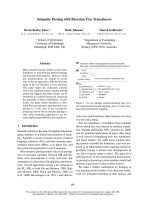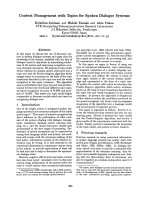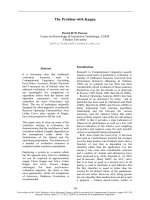Báo cáo khoa học: "Wide-coverage NLP with Linguistically Expressive Grammars" pdf
Bạn đang xem bản rút gọn của tài liệu. Xem và tải ngay bản đầy đủ của tài liệu tại đây (196.7 KB, 1 trang )
Tutorial Abstracts of ACL 2010, page 1,
Uppsala, Sweden, 11 July 2010.
c
2010 Association for Computational Linguistics
Wide-coverage NLP with Linguistically Expressive Grammars
Julia Hockenmaier
Department of Computer Science,
University of Illinois
Yusuke Miyao
National Institute of Informatics
Josef van Genabith
Centre for Next Generation Localisation,
School of Computing,
Dublin City University
1 Introduction
In recent years, there has been a lot of research
on wide-coverage statistical natural language
processing with linguistically expressive gram-
mars such as Combinatory Categorial Grammars
(CCG), Head-driven Phrase-Structure Grammars
(HPSG), Lexical-Functional Grammars (LFG)
and Tree-Adjoining Grammars (TAG). But al-
though many young researchers in natural lan-
guage processing are very well trained in machine
learning and statistical methods, they often lack
the necessary background to understand the lin-
guistic motivation behind these formalisms. Fur-
thermore, in many linguistics departments, syntax
is still taught from a purely Chomskian perspec-
tive. Additionally, research on these formalisms
often takes place within tightly-knit, formalism-
specific subcommunities. It is therefore often dif-
ficult for outsiders as well as experts to grasp the
commonalities of and differences between these
formalisms.
2 Content Overview
This tutorial overviews basic ideas of TAG/
CCG/LFG/HPSG, and provides attendees with a
comparison of these formalisms from a linguis-
tic and computational point of view. We start
from stating the motivation behind using these ex-
pressive grammar formalisms for NLP, contrast-
ing them with shallow formalisms like context-
free grammars. We introduce a common set of
examples illustrating various linguistic construc-
tions that elude context-free grammars, and reuse
them when introducing each formalism: bounded
and unbounded non-local dependencies that arise
through extraction and coordination, scrambling,
mappings to meaning representations, etc. In the
second half of the tutorial, we explain two key
technologies for wide-coverage NLP with these
grammar formalisms: grammar acquisition and
parsing models. Finally, we show NLP applica-
tions where these expressive grammar formalisms
provide additional benefits.
3 Tutorial Outline
1. Introduction: Why expressive grammars
2. Introduction to TAG
3. Introduction to CCG
4. Introduction to LFG
5. Introduction to HPSG
6. Inducing expressive grammars from corpora
7. Wide-coverage parsing with expressive
grammars
8. Applications
9. Summary
References
Aoife Cahill, Michael Burke, Ruth O’Donovan, Stefan
Riezler, Josef van Genabith and Andy Way. 2008.
Wide-Coverage Deep Statistical Parsing using Au-
tomatic Dependency Structure Annotation. Compu-
tational Linguistics, 34(1). pp.81-124, MIT Press.
Yusuke Miyao and Jun’ichi Tsujii. 2008. Feature For-
est Models for Probabilistic HPSG Parsing. Compu-
tational Linguistics, 34(1). pp.35-80, MIT Press.
Julia Hockenmaier and Mark Steedman. 2007. CCG-
bank: A Corpus of CCG Derivations and Depen-
dency Structures Extracted from the Penn Treebank.
Computational Linguistics, 33(3). pp.355-396, MIT
Press.
1









